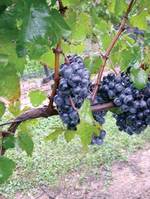By Contributing Columnist Richard Olsen-Harbich
Contrary to popular belief, rain is not always a four-letter word to the winegrower. Grapevines — like all other plants — need water to survive and grow. Early season rains help the vines start their growing season and lead them into a hopefully, long, hot summer. Improved vineyard management and disease control techniques have recently shown that late season rains have less effect on wine quality than once thought.
And, there’s another fact about rain that goes without saying — we can’t do a thing about when and where it occurs.

A lot has written and said about the 2005 harvest here on Long Island. The question I’m most often asked is “how bad did those rains affect you last fall?” My answer usually surprises people. The 2005 vintage was by far the most unusual one I have experienced in 26 years on Long Island — but it has also turned out to be one of the best.
The summer of 2005 was the driest in recent memory. The average monthly rainfall in the summer months is historically around 3.5 inches. This year, we saw a little over an inch of rain for the months of June July and August. Enough, as the locals would say, “to keep the dust down.”
Most farmers said it was the direst they’d seen since the late 1940s.
Some other data suggests it was the driest summer in almost 100 years.
By the end of September, after weeks of bright sun and warm days,
ripening was almost 2 weeks ahead of schedule. Winemakers licked their
chops in anticipation. After the white grapes were harvested with
beautiful ripeness, we waited for the reds to get just where we wanted
them…
No one thought when it started to rain in early October that it
would rain as much as it did. Most areas received between 16-20 inches
of rain in an eight-day period — enough to make up for the previous
four months.

When it finally stopped, we were blessed with a hearty breeze and
sunny days that dried out the vineyards. Some vineyards fared far
better than others, with soil type, slope and vineyard management all
being factors. There’s no question that our sandy soils did much to
alleviate the effects of the rain and luckily we had another few weeks
of protracted nice weather to finish up the season. The last grapes we
picked here at Raphael were the cabernet sauvignon on November 5.
As the sun dried out the fruit, we were amazed to find sugar at
extremely high levels. With hand-harvesting and careful sorting, we
were able to keep just the finest clusters. Most vineyards experienced
losses, however I think most winemakers would agree the result in the
tanks is phenomenal. Dark, extracted red wines are sleeping in just
about every wineries cellar these days — in my opinion, some of the
best reds ever made on Long Island. Merlot and cabernet sauvignon will
prove to be the best of this vintage.
How could this be? The summer was just so perfect and the fruit
so fully mature that eight days of rain didn’t make our fruit “less
ripe.” Our sandy soils allowed the rain to penetrate quickly past the
vine roots and permanent sod row middles directed a great deal of the
downpour into runoff. From a qualitative perspective, it was actually a
much better scenario to get 18 inches of rain in eight days than over a
period of months, as the ripening season would not have been as
favorable.
The 2005 season is indicative of the character of Long Island
winemakers. We’re tough, resilient and won’t let a little rain get in
the way of making some outstanding wines. It also speaks to the
increasing expertise of our winemakers and vineyard managers — and the
consistency of our terroir, which can overcome many obstacles to produce world-class wines.
The pudding is still a few years away – some of the 2005 whites are
already available and garnering rave reviews – but the 2005 reds will
definitely prove to be some of the best reds ever made on Long Island.
